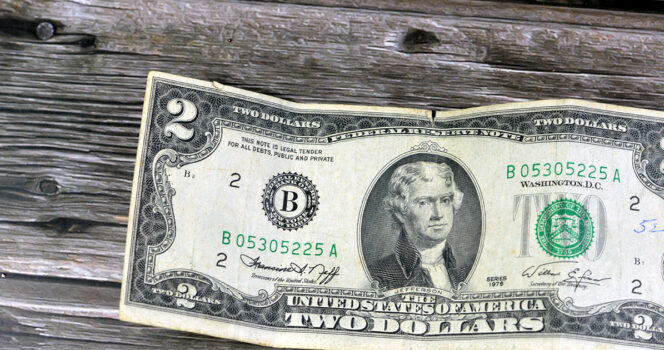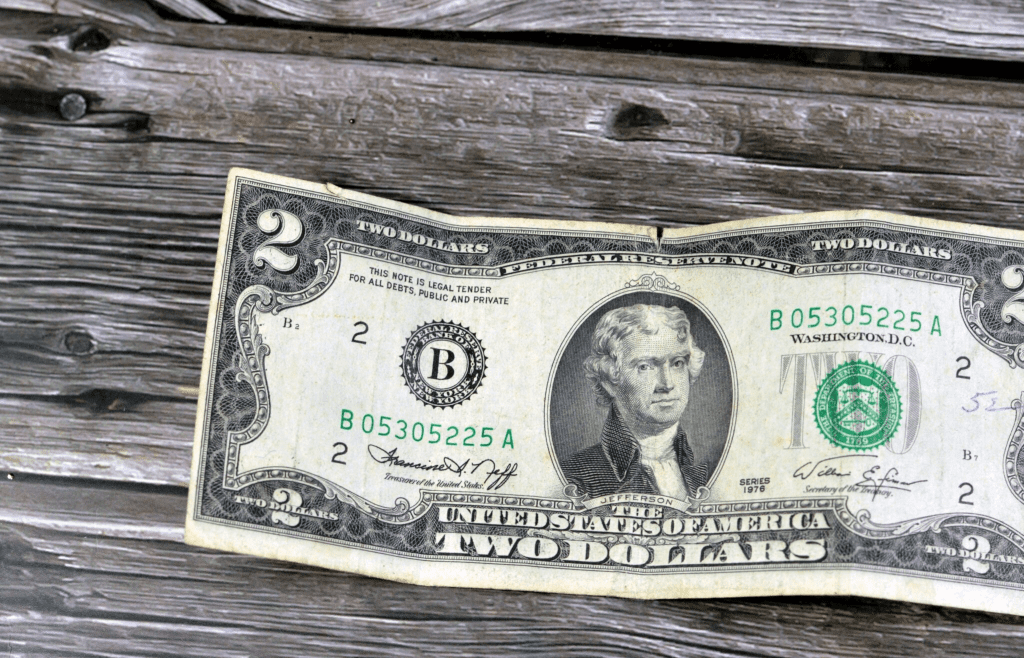That $2 Bill in Your Drawer Might Be a Hidden Treasure
If you’ve got an old $2 bill tucked away somewhere — maybe slipped inside a birthday card years ago, or quietly sitting in your wallet — it might be time to take a closer look. While some people used to think this quirky note was cursed or unlucky, the truth is far more exciting: your $2 bill could be worth way more than face value.
And no, this isn’t a myth. Some of these unassuming bills have sold for hundreds, even thousands of dollars, depending on their age, condition, and serial number. So before you spend it on a coffee, read on. That little deuce might just be your lucky charm.

Why the $2 Bill Got a Bad Rap
Back in the day, the $2 bill was treated like the black sheep of U.S. currency. Despite being officially printed in 1862, it never quite caught on with the public. Superstitions swirled around it, with whispers that it brought bad luck — especially in gambling circles. Players would even tear off a corner of the bill, hoping to break the “curse.”
By 1925, even The New York Times noted how gamblers avoided them like the plague. The stigma stuck. For decades, the $2 bill was barely used, often hoarded or tossed aside, seen as too weird, too rare, or just too unlucky.
But here’s the twist — while most people ignored the $2 bill, collectors paid attention.
Video: The Reason $2 Bills Are So Rare Today 🤔 (EXPLAINED)
How Rare Are $2 Bills Today?
Contrary to popular belief, $2 bills aren’t out of print. In fact, the Federal Reserve reports that as of 2023, there were 1.6 billion $2 bills still in circulation. Sounds like a lot, right? Until you realize that’s tiny compared to the 14.5 billion $1 bills and 11.2 billion $20 bills floating around.
Back in 2004, only about 70 million $2 bills were in circulation — that’s just a fraction of the currency in use. Slowly but surely, though, appreciation for the deuce has grown. From novelty item to collector’s favorite, the $2 bill is finally getting the recognition it deserves.
History of the $2 Bill: From Hamilton to Jefferson
Let’s rewind for a second. The very first $2 bill, printed in 1862, featured Alexander Hamilton on the front. But by 1869, that changed. Thomas Jefferson, the third U.S. president, replaced Hamilton — and he’s stayed on the note ever since.
Originally, the back of the bill featured Monticello, Jefferson’s Virginia estate. But in later versions, it was replaced with a detailed vignette of the signing of the Declaration of Independence — a fitting tribute to Jefferson’s legacy.
These changes in design over the decades have created a rich history — and a golden opportunity for collectors to find unique and valuable editions.

What Makes a $2 Bill Valuable?
So, how do you know if your $2 bill is worth more than lunch money? It all comes down to age, condition, seal color, and serial number. Let’s break it down.
- Year of Issue: Older bills = higher value. Notes from 1862 to 1896 are among the most valuable.
- Seal Color: Look closely. Red, brown, and blue seals are signs of vintage bills. Newer ones have green seals.
- Condition: If it’s crisp and clean, collectors will pay more. An uncirculated bill can be worth up to $5,000. Even worn versions from the same era may fetch $1,100.
- Serial Number: Rare or “fancy” serial numbers — like repeating digits (e.g., 22222222), palindromes, or ladder sequences — can drive the price up to $6,000.
That means your ordinary-looking bill might actually be a mini jackpot — especially if it checks more than one of these boxes.
Video: Why $2 Bills Are So Rare (not what you think) 😳
Watch for These Valuable Types
Here are a few specific examples that collectors love:
- Red Seal Bills (1928, 1953, 1963): These are some of the most collected. Depending on condition, they range from $10 to $500.
- Blue Seal Bills (1917 and earlier): Rare and highly sought after — even in average condition, they’re worth hundreds.
- Brown Seal Nationals (1800s): If you’ve got one of these, call a professional. These can be worth thousands.
- 1963 Bills with Star Serial Numbers: These are known as replacement notes and are rare. Keep an eye out for a star (*) at the beginning or end of the serial number.
And don’t forget: the less wear and tear, the more money it’s worth.
Where to Sell or Value Your $2 Bill
Ready to find out what your bill’s worth? Don’t just toss it into your next tip jar. You can:
- Check Online Auctions – Sites like eBay or USCurrencyAuctions.com often feature $2 bills with current bid prices.
- Visit a Currency Dealer – A certified appraiser can give you an accurate value based on the condition and rarity.
- Look for Collector Events – Coin and currency expos often bring together buyers and sellers looking for these kinds of gems.
Just be sure to verify the credibility of the buyer. Scammers prey on people who don’t know what they’re holding.
The Comeback of the $2 Bill
Believe it or not, the $2 bill is having a moment. It’s no longer seen as odd or unlucky — now it’s quirky, collectible, and kind of cool. People are starting to gift them again, frame them, even use them as conversation starters.
There’s even a 2015 documentary, The Two Dollar Bill, that dives into the bill’s strange journey — from superstition to collector obsession.
Went to withdraw a bunch of $2 bills for WPAFW, and one of them was almost 100 years old pic.twitter.com/9i1bL4BXaY
— Sketchy Mouse (@SketchyMouse) September 27, 2024
Conclusion: Don’t Underestimate the Deuce
So before you laugh off that $2 bill in your wallet, give it a second look. It may be more than a novelty. It might be a rare piece of American history — and a surprisingly valuable one at that.
Whether you’re a casual saver or a budding collector, the takeaway is simple: what looks ordinary could be extraordinary. In a world of digital payments and disappearing cash, that quirky little bill could be your next big surprise.
Check your drawers. Flip through your old birthday cards. You just might be sitting on a small fortune.